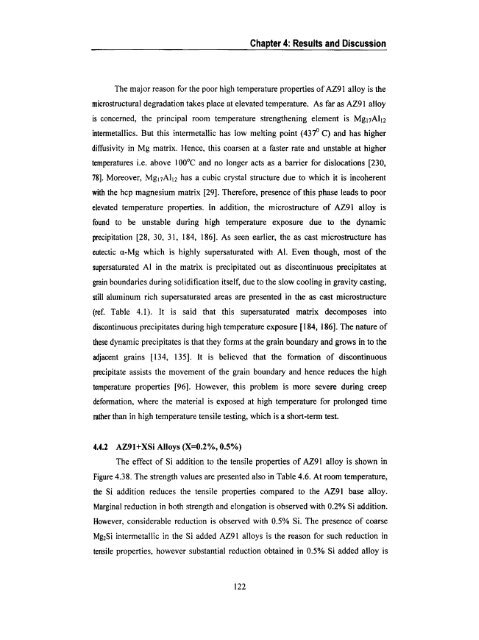“Influence of Si, Sb and Sr Additions on the Microstructure ...
“Influence of Si, Sb and Sr Additions on the Microstructure ...
“Influence of Si, Sb and Sr Additions on the Microstructure ...
You also want an ePaper? Increase the reach of your titles
YUMPU automatically turns print PDFs into web optimized ePapers that Google loves.
_ pg Chapter 4: Results <str<strong>on</strong>g>and</str<strong>on</strong>g> Discussi<strong>on</strong><br />
The major reas<strong>on</strong> for <strong>the</strong> poor high temperature properties <str<strong>on</strong>g>of</str<strong>on</strong>g> AZ91 alloy is <strong>the</strong><br />
microstructural degradati<strong>on</strong> takes place at elevated temperature. As far as AZ91 alloy<br />
is c<strong>on</strong>cemed, <strong>the</strong> principal room temperature streng<strong>the</strong>ning element is Mg17Al;;;<br />
intermetallics. But this intermetallic has low melting point (4370 C) <str<strong>on</strong>g>and</str<strong>on</strong>g> has higher<br />
diffusivity in Mg matrix. Hence, this coarsen at a faster rate <str<strong>on</strong>g>and</str<strong>on</strong>g> unstable at higher<br />
temperatures i.e. above l00°C <str<strong>on</strong>g>and</str<strong>on</strong>g> no l<strong>on</strong>ger acts as a barrier for dislocati<strong>on</strong>s [230,<br />
78]. Moreover, Mg17Al12 has a cubic crystal structure due to which it is incoherent<br />
with <strong>the</strong> hcp magnesium matrix [29]. Therefore, presence <str<strong>on</strong>g>of</str<strong>on</strong>g> this phase leads to poor<br />
elevated temperature properties. In additi<strong>on</strong>, <strong>the</strong> microstructure <str<strong>on</strong>g>of</str<strong>on</strong>g> AZ91 alloy is<br />
found to be unstable during high temperature exposure due to <strong>the</strong> dynamic<br />
precipitati<strong>on</strong> [28, 30, 31, 184, 186]. As seen earlier, <strong>the</strong> as cast microstructure has<br />
eutectic o-Mg which is highly supersaturated with Al. Even though, most <str<strong>on</strong>g>of</str<strong>on</strong>g> <strong>the</strong><br />
supersaturated Al in <strong>the</strong> matrix is precipitated out as disc<strong>on</strong>tinuous precipitates at<br />
grain boundaries during solidificati<strong>on</strong> itself, due to <strong>the</strong> slow cooling in gravity casting,<br />
still aluminum rich supersaturated areas are presented in <strong>the</strong> as cast microstructure<br />
(ref. Table 4.1). It is said that this supersaturated matrix decomposes into<br />
disc<strong>on</strong>tinuous precipitates during high temperature exposure [184, 186]. The nature <str<strong>on</strong>g>of</str<strong>on</strong>g><br />
<strong>the</strong>se dynamic precipitates is that <strong>the</strong>y forms at <strong>the</strong> grain boundary <str<strong>on</strong>g>and</str<strong>on</strong>g> grows in to <strong>the</strong><br />
adjacent grains [l34, 135]. it is believed that <strong>the</strong> formati<strong>on</strong> <str<strong>on</strong>g>of</str<strong>on</strong>g> disc<strong>on</strong>tinuous<br />
precipitate assists <strong>the</strong> movement <str<strong>on</strong>g>of</str<strong>on</strong>g> <strong>the</strong> grain boundary <str<strong>on</strong>g>and</str<strong>on</strong>g> hence reduces <strong>the</strong> high<br />
temperature properties [96]. However, this problem is more severe during creep<br />
deformati<strong>on</strong>, where <strong>the</strong> material is exposed at high temperature for prol<strong>on</strong>ged time<br />
ra<strong>the</strong>r than in high temperature tensile testing, which is a short-term test.<br />
4.4.2 AZ91+X<str<strong>on</strong>g>Si</str<strong>on</strong>g> Alloys (X=0.2%, 0.5%)<br />
The effect <str<strong>on</strong>g>of</str<strong>on</strong>g> <str<strong>on</strong>g>Si</str<strong>on</strong>g> additi<strong>on</strong> to <strong>the</strong> tensile properties <str<strong>on</strong>g>of</str<strong>on</strong>g> AZ91 alloy is shown in<br />
Figure 4.38. The strength values are presented also in Table 4.6. At room temperature,<br />
<strong>the</strong> <str<strong>on</strong>g>Si</str<strong>on</strong>g> additi<strong>on</strong> reduces <strong>the</strong> tensile properties compared to <strong>the</strong> AZ91 base alloy.<br />
Marginal reducti<strong>on</strong> in both strength <str<strong>on</strong>g>and</str<strong>on</strong>g> el<strong>on</strong>gati<strong>on</strong> is observed with 0.2% <str<strong>on</strong>g>Si</str<strong>on</strong>g> additi<strong>on</strong>.<br />
However, c<strong>on</strong>siderable reducti<strong>on</strong> is observed with 0.5% <str<strong>on</strong>g>Si</str<strong>on</strong>g>. The presence <str<strong>on</strong>g>of</str<strong>on</strong>g> coarse<br />
Mg2<str<strong>on</strong>g>Si</str<strong>on</strong>g> intermetallic in <strong>the</strong> <str<strong>on</strong>g>Si</str<strong>on</strong>g> added AZ91 alloys is <strong>the</strong> reas<strong>on</strong> for such reducti<strong>on</strong> in<br />
tensile properties, however substantial reducti<strong>on</strong> obtained in 0.5% <str<strong>on</strong>g>Si</str<strong>on</strong>g> added alloy is<br />
122
















